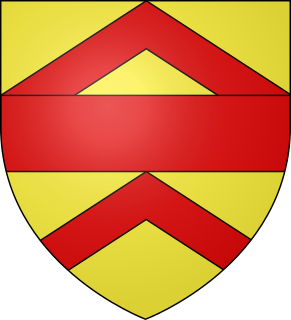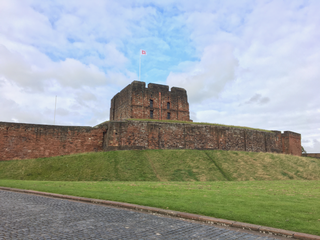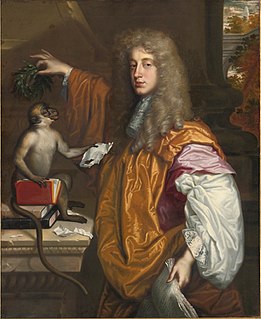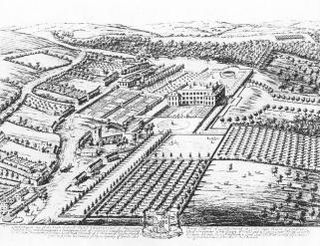Related Research Articles

Earl of the County of Cork, usually shortened to Earl of Cork, is a title in the Peerage of Ireland, held in conjunction with the Earldom of Orrery since 1753. It was created in 1620 for the Anglo-Irish politician Richard Boyle, 1st Baron Boyle. He had already been created Lord Boyle, Baron of Youghal, in the County of Cork, in 1616, and was made Viscount of Dungarvan, in the County of Waterford, at the same time he was given the earldom. These titles are also in the Peerage of Ireland.

Earl of Derby is a title in the Peerage of England. The title was first adopted by Robert de Ferrers, 1st Earl of Derby, under a creation of 1139. It continued with the Ferrers family until the 6th Earl forfeited his property toward the end of the reign of Henry III and died in 1279. Most of the Ferrers property and the Derby title were then held by the family of Henry III. The title merged in the Crown upon Henry IV's accession to the throne in 1399.

Henry Bennet, 1st Earl of Arlington, KG, PC was an English statesman.
Duke of Cumberland is a peerage title that was conferred upon junior members of the British Royal Family, named after the historic county of Cumberland.

Earl of Leicester is a title that has been created seven times. The first title was granted during the 12th century in the Peerage of England. The current title is in the Peerage of the United Kingdom and was created in 1837.

Baron FitzWalter is an ancient title in the Peerage of England. It was created on 24 June 1295 for Robert FitzWalter. The title was created by writ, which means that it can descend through both male and female lines. His great-grandson, the fourth baron, was an Admiral of the Fleet. The fourth baron's grandson, the sixth baron, died from dysentery at the siege of Harfleur. He was succeeded by his brother, the seventh baron, who was the last known male line descendant of Rollo of Normandy, was succeeded by his daughter and only child, Elizabeth. She was the wife of John Radcliffe. Their son, the ninth baron, was attainted for treason in 1495 with his title forfeited. However, his son Robert Radcliffe obtained a reversal of the attainder by Act of Parliament in 1509 and later served as Lord Lieutenant of Lancashire. He was created Viscount FitzWalter in 1525 and Earl of Sussex in 1529. His grandson, the third earl, was summoned to the House of Lords through a writ of acceleration in 1553 in his father's junior title of Baron FitzWalter. Lord Sussex later served as Lord Deputy of Ireland. He was succeeded by his younger brother, the fourth earl. He had earlier represented Maldon, Hampshire and Portsmouth in the House of Commons and also served as Lord Lieutenant of Hampshire. When he died the titles passed to his only child, the fifth earl. He was Lord Lieutenant of Essex.

Baron de Clifford is a title in the Peerage of England. It was created in 1299 for Robert de Clifford (c.1274–1314), feudal baron of Clifford in Herefordshire, feudal baron of Skipton in Yorkshire and feudal baron of Appleby in Westmoreland. The title was created by writ, which means that it can descend through both male and female lines. The Norman family which later took the name de Clifford settled in England after the Norman Conquest of 1066 and was first seated in England at Clifford Castle in Herefordshire. The first Baron served as Earl Marshal of England but was killed at the Battle of Bannockburn in 1314. His 8th generation descendant the 11th Baron, was created Earl of Cumberland in 1525, whose grandson the 3rd Earl was a noted naval commander. On the latter's death in 1605 the earldom passed to his younger brother, the 4th Earl.

Carlisle Castle is in Carlisle, in the English county of Cumbria, near the ruins of Hadrian's Wall. The castle is over 900 years old and has been the scene of many historical episodes in British history. Given the proximity of Carlisle to the border between England and Scotland, it has been the centre of many wars and invasions. During the Jacobite Rising of 1745–6, Carlisle became the last English fortress to undergo a siege. The castle was listed as a Scheduled Ancient Monument on 7 August 1996.

Earl of Rochester was a title that was created twice in the Peerage of England. The first creation came in 1652 in favour of the Royalist soldier Henry Wilmot, 2nd Viscount Wilmot. He had already been created Baron Wilmot, of Adderbury in the County of Oxford, in 1643, also in the Peerage of England. He was the son of Charles Wilmot, who had been elevated to the Peerage of Ireland as Viscount Wilmot, of Athlone, in 1622. Lord Rochester died in 1658 and was succeeded by his son John Wilmot, 2nd Earl of Rochester. He was a poet, a friend of King Charles II, and the writer of satirical and bawdy poetry. He married the heiress Elizabeth Malet. He was succeeded on his death in 1680 by his only son, the third Earl. He died at a young age the following year, when the titles became extinct.

Earl of the Isle of Thanet, in practice shortened to Earl of Thanet, was a title in the Peerage of England. It was created in 1628 for Nicholas Tufton, 1st Baron Tufton. He had already succeeded as second Baronet of Hothfield in 1631 and been created Baron Tufton, of Tufton in the County of Sussex, in 1626, also in the Peerage of England. The Baronetcy, of Hothfield in the County of Kent, was created in the Baronetage of England in 1611 for his father, John Tufton. Lord Thanet was succeeded by his son, the second Earl. He married Lady Margaret Sackville, daughter of Richard Sackville, 3rd Earl of Dorset and Lady Anne Clifford. Their son, the third Earl, successfully claimed the barony of de Clifford through his maternal grandmother Lady Anne.

Londesborough Hall is a country house in the village of Londesborough in the East Riding of Yorkshire, England, close to the towns of Market Weighton and Pocklington.

Philip Herbert, 4th Earl of Pembroke and 1st Earl of Montgomery, was an English courtier, nobleman, and politician active during the reigns of James I and Charles I. Philip and his older brother William were the 'incomparable pair of brethren' to whom the First Folio of Shakespeare's collected works was dedicated in 1623.

Sir George Clifford, 3rd Earl of Cumberland, 13th Baron de Clifford, 13th Lord of Skipton,, was an English peer, naval commander, and courtier of Queen Elizabeth I of England. He was notable at court for his jousting, at the Accession Day Tilts, which were highlights of the year at court. Two famous survivals, his portrait miniature by Nicholas Hilliard and a garniture of Greenwich armour, reflect this important part of his life. In contrast, he neglected his estates in the far north of England, and left a long succession dispute between his heirs.

Baron Clifford is a title in the Peerage of England created by writ of summons on 17 February 1628 for Henry Clifford, Lord Clifford. The title was believed to be held by Lord Clifford's father and descending to Lord Clifford via a writ of acceleration, but it would later be determined that the Clifford title held by that family had passed to a female relative, so the summons of 1628 unintentionally created a new title. Lord Clifford inherited his father's title in 1641, whereupon he sat in the House of Lords as Earl of Cumberland until his death in 1643.
This is a list of people who have served as Custos Rotulorum of Cumberland.

Brougham Castle is a medieval building about 2 miles (3.2 km) south-east of Penrith, Cumbria, England. The castle was founded by Robert I de Vieuxpont in the early 13th century. The site, near the confluence of the rivers, Eamont and Lowther, had been chosen by the Romans for a Roman fort called Brocavum. The castle, along with the fort, is a scheduled monument: "Brougham Roman fort and Brougham Castle".

Henry Clifford, 1st Earl of Cumberland KG was a member of the Clifford family which was seated at Skipton Castle, Yorkshire from 1310 to 1676.

Henry Clifford, 5th Earl of Cumberland was an English landowner and politician who sat in the House of Commons between 1614 and 1622. He was created a baron in 1628 and succeeded to the title Earl of Cumberland in 1641.
Vipont is the name of a prominent family in the history of Westmorland. According to Thomas the name originated in France before 1066 as Vieuxpont, Latinized to de Vetere Ponte, with alternative spellings Vezpont, Veepon, Vexpont, Vypont, Vispont, Vypunt, Vespont, Vipond, Vypond, Voypond, Veepond, Vippond, Vipon, Vipan, Vipen, etc. The Vipont family bore arms: Gules, six annulets or 3:2:1, later quartered by Baron Clifford.
Sir Thomas Parr was an English landowner and elected Member of Parliament six times between 1435 and 1459. He was great-grandfather of Queen Catherine Parr, the sixth wife of King Henry VIII.